State of Design 2015
Once a year, I write a column where I examine how I feel the previous year of design went. The column, called the "State of Design," is modeled after a speech the US president gives once a year called the State of the Union. In today's column, I am going to examine what I felt went best about the last year of Magic design and also what went worst. I will also look at three goals I set for myself last year and grade how we did. This is my eleventh "State of Design." Here are the previous ten:
I always start by asking the same question: How was the last year for Magic design? I think it was a ten on concept, but only a seven on execution. We did a lot right and I feel we left the three-set block model with one of most ambitious attempts at making it work. That said, we also missed on a few things that kept the Khans of Tarkir block from being the high-point of Magic design that it could have been. What went right and what went wrong? Let's talk about it.
We'll begin with what we got right:
Highlights of 2014/2015
The Clans Were a Huge Success
Very early in Khans of Tarkir's design, I was having a one-on-one with my boss, Aaron Forsythe. He expressed concern with the block structure. We were going to introduce a world which we were then going to change into a Dragon-filled world. Aaron's concern was how we would make the first world exciting enough that it could possibly compete with a world filled to the gills with Dragons. I told him not to worry, I'd make it happen. Well, I succeeded, maybe a little too well.
The clans went over spectacularly. Players loved the flavor, they loved the gameplay, they loved the clan mechanics; they loved the feel of the clans, and they loved the wedges. They loved it so much that the biggest complaint about the entire block was the sadness that Tarkir ended up with Dragons instead of the clans.
Design (and development, and creative, and the rest of R&D—I'm just focusing on design in this column) spent a lot of time and energy making sure that each clan had a very strong mechanical identity, that you got a sense of what the clan was like by playing it. I feel like this was a home run for us. Every clan had a distinctive mechanical feel that worked in isolation, but also combined well with elements from other clans in gameplay. Prowess was such a success that we went on to make it evergreen. The mechanic that was least loved was ferocious, and I feel a lot of that was because it felt more like a repeat of Naya (the red-green-white shard from Shards of Alara) and thus not enough of a new thing.
Factions yet again proved to be a powerful design tool, something that should continue to have a big impact on Magic design's future.
Manifest Was a Huge Success
Manifest, then called "recruit," was made by the Khans of Tarkir exploratory design team. We really liked how it played and what it did for the larger block structure; we could use a single mechanic to express the changing of the sets throughout the block. The problem was it was a pretty complex mechanic in a block that was already high in complexity. But the mechanic was very fun, so we pushed to keep it. I honestly wasn't sure whether or not the mechanic was going to make it through development, but fun gameplay won out over a number of other valid concerns.
Luckily, the players embraced it. It did a good job of being a proto-version of morph for flavor reasons. It played really nicely with morph. It was novel and executed well by Ken Nagle and his Fate Reforged design team. Just everything about it worked and, as predicted, it was fun.
Design walks a tightrope between trying to innovate and do cool new things while also keeping the game's complexity from spiraling out of control. We have to be very careful about where and how we use complex mechanics. Manifest, though, is an example of where I believe complexity was used successfully.
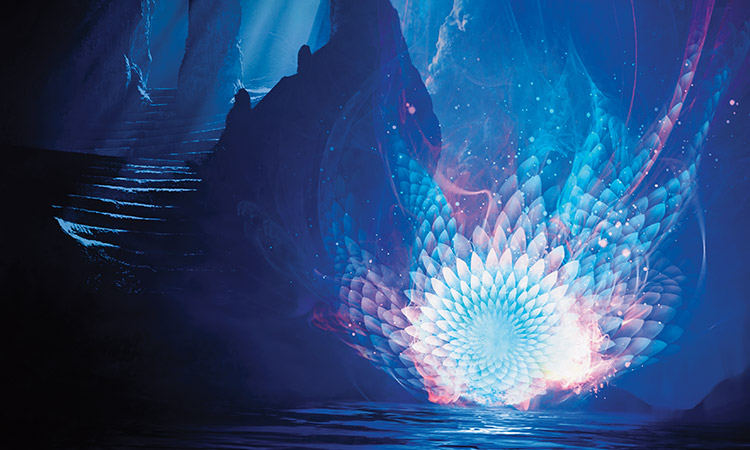
Rageform | Art by Richard Wright
We Made the Block Structure Work
We didn't know going into this block that it was going to be the last three-set block, but in retrospect I don't believe the three-block system could have asked for a nicer farewell. Khans of Tarkir block did something only a three-block set could do and, while there were issues (more on those in a minute), I believe the block managed to deliver on its promises.
First, it proved to be an interesting Draft structure that actually lived up to its concept. I feel design did a good job setting up the tools for Erik Lauer and his development team to deliver on. I believe looking back through history, this will be a Draft environment that players remember.
Second, it proved to be an interesting flavor concept. There were a number of skeptics when I first pitched the time travel structure, but I think everyone (with a special nod to the creative team) did a great job of getting the sets to realize the premise. The connection between the present, past, and alternate present were all woven throughout the cards, and the net result was something that I believe was enjoyed by many.
Lessons of 2014/2015
Not everything went wonderfully, though.
We Messed Up with Dragons
A set filled with Dragons seemed like a slam dunk. We've done lots of market research, and players love Dragons. It was a set that would design itself. Interestingly, our biggest design mistake of the year was complacency.
We made a whole bunch of mistakes here, so I'm going to run through all the major ones:
#1: Don't Make the Set Before the Dragon Set Also Be a Dragon Set
Dragons of Tarkir had the most Dragons ever in the history of the game, beating the record of . . . Fate Reforged. If you want to make something exciting, you probably need to refrain from putting that element into the thing that comes right before—especially in large numbers. Fate Reforged flavorfully wanted a lot of Dragons, as Sarkhan went back in time to when Dragons were still alive, and we felt it was important to see the Dragons. In retrospect, we should have found ways to show that the Dragons were there with fewer Dragon cards in the set. I would have kept the rare cycle of legendary Dragons (as that did need to be there) and pull the rest of the Dragons from the set, especially the common. That card should have been in Dragons of Tarkir, because the set really, really wanted a common Dragon (see below). This way, Fate Reforged would introduce the five important Dragons, but their footprint in the set would have been tiny and it wouldn't have satiated the desire for Dragons.
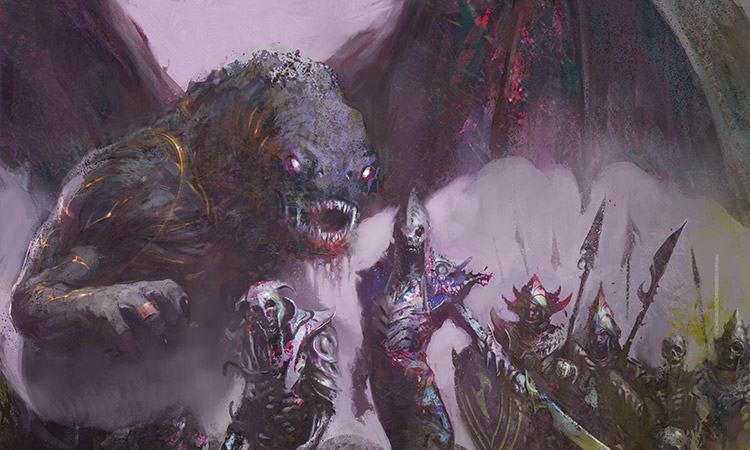
Silumgar's Command | Art by Nils Hamm
#2: Dragons of Tarkir Should Have Had a Common Dragon
As I like to say (and many people reminded me when Dragons of Tarkir came out), "If your theme isn't at common, it isn't your theme." Design did make a common Dragon, but when that got pushed up to uncommon in development, we should have figured out a way to make a workable common Dragon (stealing the Fate Reforged one now seems like a no-brainer).
#3: Dragons Needed More Variety
We spread the Dragons across all the colors, but we did little else to create variety. Baby Dragons were off the table because of the story (although I do wish I challenged this idea in retrospect), and as a result, all the Dragons tended to fall into the same size range. Looking back, I've now realized that if you're going to push a particular component design-wise, you have to look at how to increase variety so that you can make designs that feel very different from one another. Yes, Dragons of Tarkir had 26 Dragons, but they were just too similar to one another. We needed to work to give them a little more mechanical personality.
#4: We Misunderstood How Dragons Are Perceived
Yes, Dragons are beloved, but not by all players. In particular, Dragons historically have not been tournament-level cards, meaning that a certain subset of the players don't have a positive impression of Dragons. "Hey, it's a set dedicated to a Timmy/Tammy thing that's probably not going to affect you."
Erik Lauer and his developers did work hard to make tournament-viable Dragons, but it took a while for players to realize that was true. I'm not sure if this mistake stemmed from choosing Dragons as the theme or not having a larger context to make the set sound more appealing to a bigger group of players.
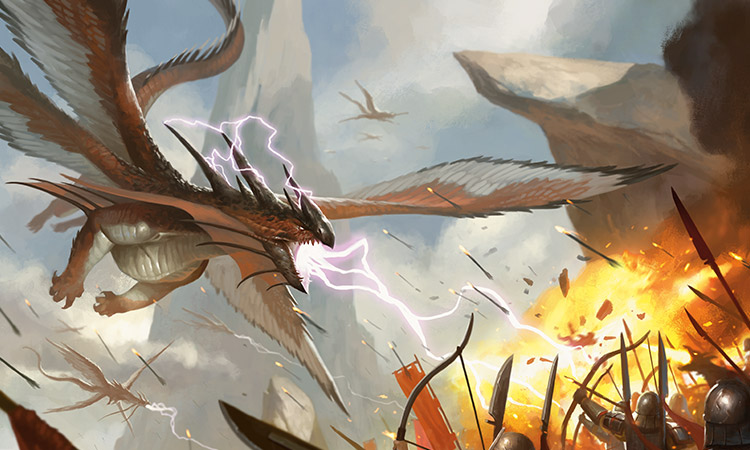
Outpost Siege | Art by Daarken
Megamorph was a Mega-Disappointment
Some mechanics were better liked than others, but I feel only one mechanic reached the point where it was disliked by the majority of players. Interestingly, when I talk to players about megamorph, most admit it actually played well, but they still didn't like it. Here are my thoughts on why:
#1: It Compared Poorly
If megamorph was its own mechanic in its own block, it would probably have fared okay—but it was the morph variant in the alternate-present set. The players had enjoyed morph coming back. They really enjoyed the variant of manifest. There was a lot of expectation for the final morph variant, and megamorph under that lens simply didn't live up. I think we thought that good gameplay would be enough, but there was just anticipation for something more, which megamorph did not deliver on.
#2: It Wasn't Novel Enough
This is an offshoot of the last point. Players, due to manifest, were expecting something more surprising. The block hinted at an alternate-reality version of morph that was just more "out there."
In retrospect, I wish we had gone with the variant we called "smorph" in design. A creature with smorph is played facedown for four, but enters the battlefield with a +1/+1 counter. It was the precursor to megamorph and thus had a similar feel in play on the backend, but was a little more out-of-the-box and would have played differently because four mana for a 3/3 is just so different than three for a 2/2. The reason we didn't do it was it played poorly with morph, because you knew by the +1/+1 counter it wasn't a morph creature. But the two never played together in Limited and morph didn't show up enough in Constructed to make this problem matter enough.
#3: The Name Sucked
The name "megamorph" came from design. We wanted "morph" in the name so that players understood it played similarly to morph, but we just didn't take into account that, in a vacuum, the name sounded silly. The name isn't the major fail point, but it definitely didn't help make a good first impression.
We Left Tarkir in the Wrong State
For most of the other mistakes, I think I know what I'd do if I had to do the block over again. The solution to this one, though, is far less obvious. Magic has a long history of creating cool, exciting worlds and then trashing them. I believe it is one of the biggest issues with a three-set block, that the need to make the last set so different mechanically pushes us to do radical things to the world to match the environmental shift.
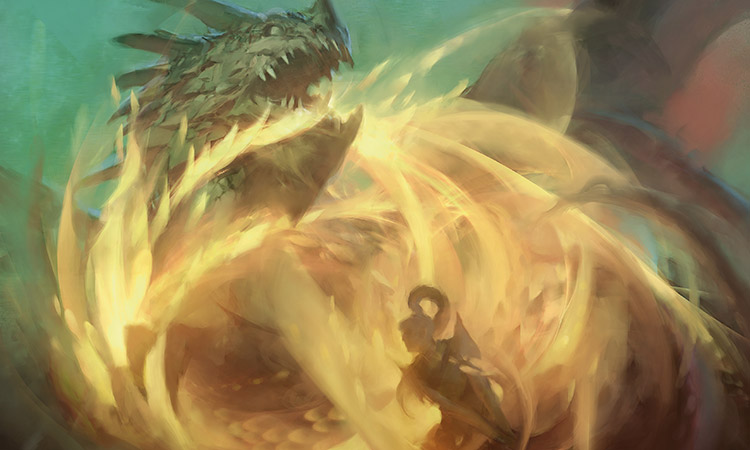
Obscuring Æther | Art by Min Yum
Long ago, we saw mechanics as disposable; we then came to realize that they were valuable tools we could reuse. I think in many ways we used to see worlds in the same way. We visit and move on. But now we're realizing we've built cool places we want to go back to. That gets us to this problem. We made a very compelling world that players fell in love with, and then we changed it to a less compelling world forever. Now, I don't believe we thought we were doing that. We over-valued the Dragon-filled world and underestimated the warlord clan world.
This also ties into another problem. One of the reasons we chose a wedge theme for Khans of Tarkir was because we knew it wasn't mechanically deep enough to use for an entire block. But by giving players a taste of wedge in the beginning, we set up a desire for us to deliver that for the whole block when there was no way we could.
What do these two things mean? It means with 20/20 hindsight, we did the change backwards. We should have started with Dragons, probably with another layer added in and then had the world change to clan-filled wedge world. Players would have been excited to get wedge without any expectation for more as the block would have ended.
The reason this change is so problematic is that we went to Tarkir, Sarkhan's homeworld, because we wanted to end with Dragons. Tarkir was a world defined as having no Dragons, so starting with Dragons would have required a completely different world—meaning this is a messy problem with no easy solution.
Aiming for the Goal
As I've covered the highs and lows, let's get to how we did on the goals from last year's State of Design.
2015 Goal #1: Prove We Can Handle the Volume without Excess Complexity
Khans of Tarkir block had ten clan mechanics. In addition, it had the return of one of the most complex mechanics in Magic's history—morph. But not just morph—it also had two variants on morph, and one of those was extra complex. That was a lot. Design worked hard to make sure all the non-morph mechanics were on the simpler side, and we connected the ten clan mechanics so they played nicely with one another.
How'd we do? I think for the volume of mechanics we juggled, we did well, but we still bit off way more than we were supposed to. Looking back, I question the inclusion of morph and its variants. The block could have just had the ten clan mechanics and been fine. Yes, it would have been different, but I think we could have made a very compelling design. But the entire set was built around morph—so by the time I realized what was going on, it wasn't something we could take out.
I believe experienced players had a lot of fun with Khans of Tarkir block and the pendulum of complexity needs to swing, but I also believe this was a harder than average block for a new player to start with and we have to remember that there are always new players. New World Order was created to make sure the entry point to the game was always accessible, and Khans of Tarkir block definitely pushes at the boundaries of that.
With all that said, I'm giving us half a thumb up. Design did a lot to make everything play smoothly together, and we worked hard to make sure that the majority of the mechanics were simple and easy to learn. We lose half a thumb because, while we did noble work, we didn't reach the level I would have liked. Quite possibly, it may have been impossible with all the mechanics we had, but that just means maybe we had too many.
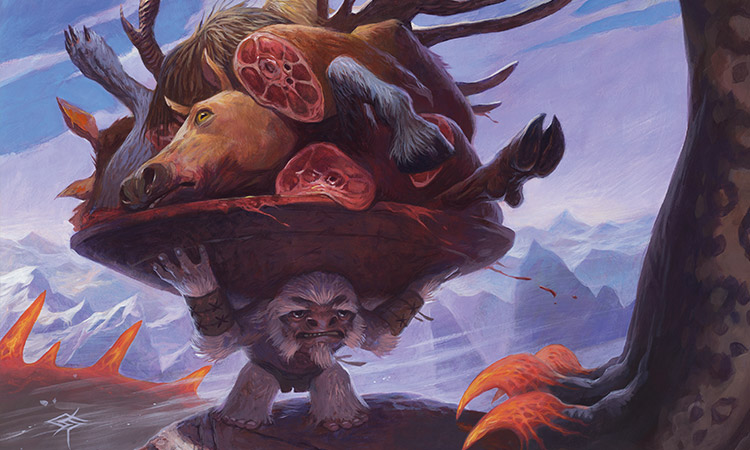
Dragonlord's Servant | Art by Steve Prescott
2015 Goal #2: Demonstrate That the Block Model Works
I feel pretty good about this goal. We started with a pretty lofty block structure, and I'm happy to say at the end of the day, I feel design did a good job bringing it all together (obviously with the amazing help of the rest of R&D). The Draft format was interesting. The time travel structure led to a lot of fun opportunities for card design. All in all, a big thumbs up from me for this goal.
2015 Goal #3: Execute Properly on Fate Reforged
Ken Nagle is my most seasoned design veteran after myself. I hand-picked him to lead Fate Reforged's design, because I knew it was going to be difficult but that he would rise to the occasion. He did and I really enjoyed what he and his team (which includes me, so talking in third person is a bit odd) were able to accomplish. The hybrid solution, in particular, was some beautiful design work.
The other thing that I really enjoyed from a design aspect was how the set did one thing when paired with Khans of Tarkir but a different thing when paired with Dragons of Tarkir. That was the whole point of it being a pivot set, and I am happy that we were able to realize the potential of the idea. Another thumbs up here.
Like last year, we ended at two-and-a-half thumbs. (Maybe the thumb metaphor is odd with three goals.) That matches what I said up front, in that I thought this was a positive year but not a complete success.
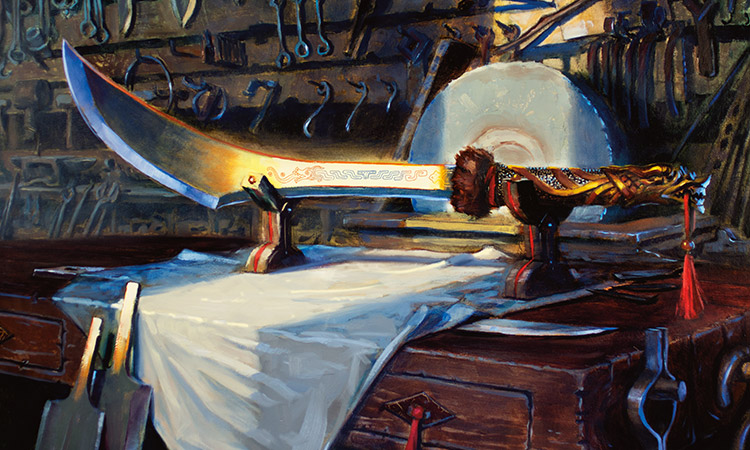
Hero's Blade | Art by Aaron Miller
Looking Forward
Now comes the time in my State of Design where I share the goals for next year. I have decided to stop doing that for a few reasons. One, every year when I do my goals, I get a lot of complaints because I'm picking the goals. How do we not succeed when I get to pick what we're judged on? Two, we now have two blocks instead of one and while I'm willing to tease Battle for Zendikar block, I can't tease the one after (you all don't even know its name yet—ooh, but it's going to be cool), which makes setting goals tricky. Three, I haven't restructured my State of Design since I started it eleven years ago, and it feels like time for a change. I'm not quite sure what other changes I want to make, but the removal of the goals will give me some room next year to play with the format of the column.
And That Was the Year That Was
One of the reasons I do a State of Design column each year is to let all of you know where I think design is at. An important part of this process is hearing from all of you about what you think. How was the last year of design for you? Write me an email or talk to me through any of my social media accounts (Twitter, Tumblr, Googe+, and Instagram). I am very curious to hear your opinions.
Join me next week when I revisit Vorthos and Mel(vin).
Until then, may you take a look back at your own hits and misses.
"Drive to Work #254—Khans of Tarkir, Part 1"
This is part one of a seven-part series on the design of Khans of Tarkir.
"Drive to Work #255—Khans of Tarkir, Part 2"
This is part two of a seven-part series on the design of Khans of Tarkir.
- Episode 255 Khans of Tarkir, Part 2 (15.3 MB)
- Episode 254 Khans of Tarkir, Part 1 (14.2 MB)
- Episode 253 Red-White (13.9 MB)
- Episode 252 Block Inspirations, Part 2 (15.9 MB)
- Episode 251 Block Inspirations, Part 1 (14.6 MB)

